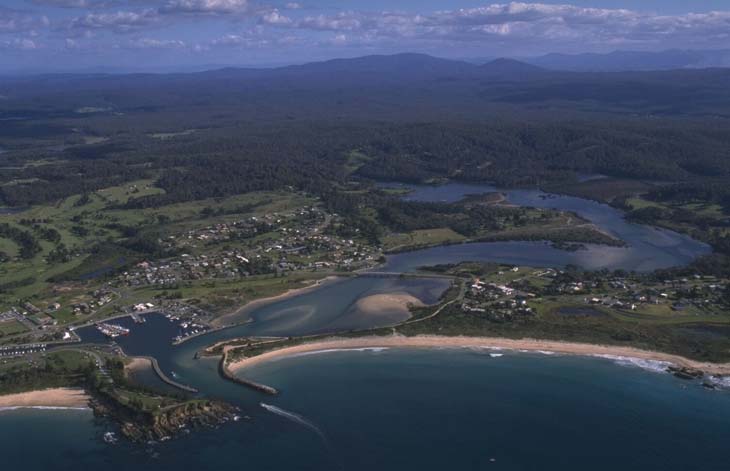Bermagui River is a barrier river estuary with an open, trained entrance. It is located on the far south coast of New South Wales and flows next to the town of Bermagui and into the sea at Bermagui Point.
The Bermagui River estuary is popular for activities such as boating, fishing and kayaking. It is also commercially important for oyster farming and marine operations at the Port of Bermagui.
Water quality report card
As part of our water quality monitoring program we assess the water quality and ecosystem health of an estuary using a range of relevant indicators. We sample a subset of the estuaries between Wollongong and the Victorian border every 3 years. The most recent sampling in the Bermagui River Lake was completed over the 2017–18 summer, when 2 sites were sampled on a monthly basis.
This report card represents 2 water quality indicators that we routinely measure: the amount of algae present and water clarity. Low levels of these 2 indicators equate with good water quality.
Algae
Water clarity
Overall grade
The report card shows the condition of the estuary was good with:
- algae abundance graded good (B)
- water clarity graded excellent (A)
- overall estuary health graded good (B).
Grades for algae, water clarity and overall are represented as:
- A – excellent
- B – good
- C – fair
- D – poor
- E – very poor.
Go to estuary report cards to find out what each grade means, read our sampling, data analysis and reporting protocols, and find out how we calculate these grades.
We have monitored water quality in the Bermagui River estuary since 2011. This table shows the water quality grades for this estuary over that time.
| Year | Algae | Water clarity | Overall grade |
|---|---|---|---|
| 2011–12 | A | A | A |
Physical characteristics
| Estuary type | Barrier river |
|---|---|
| Latitude | –36.42 (ºS) |
| Longitude | 150.07 (ºE) |
| Catchment area | 83.5 km2 |
| Estuary area | 2.2 km2 |
| Estuary volume | 2160.2 ML |
| Average depth | 1.1 m |
Tidal exchange volume
Tidal exchange volume or tidal prism data is available for this estuary. This tidal prism was measured in 1990.
| Tide state | Flow (ML) | Local tidal range (m) | Sydney Harbour tidal range (m) |
|---|---|---|---|
| Ebb flow | 2,500 | 1.55 | 1.56 |
| Flood flow | 2,500 | 1.3 | 1.35 |
Notes: km2 = square kilometres; m = metres; m3 = cubic metres; ML = megalitres.
Water depth and survey data
Bathymetric and coastal topography data for this estuary are available in our data portal.
Land use
The catchment of Bermagui River is moderately disturbed, with 35% of land cleared for grazing south-west of Cobargo. The urban area of Bermagui occupies 5% of the catchment. Two-thirds of the catchment is forest that encompasses most of Biamanga National Park.
Web cam
The Bermagui River bar crossing web camera provides real-time video of conditions within the river entrance immediately offshore to help with bar crossings and boat safety.
National and marine parks
- The largest conservation area in the Bermagui River catchment is the Biamanga National Park.
- This estuary does not flow into a marine park.
Citizen science projects
- The Far South Coast Conservation Management Network supports the local community to better manage native biodiversity. The network organises citizen science projects, provides information for private landowners, manages a local plant database, and coordinates events.
Community involvement
- Bermagui Dune Care Group is a small group working to revegetate the coastal area near Bermagui.
- The Bega River and Wetlands Landcare Group is a volunteer group dedicated to improving the health of the Bega River, wetlands and floodplains.
- The Far South Coast Landcare Association is a volunteer environmental and conservation organisation that works to improve management of local land and water.

Aerial view of Bermagui River
Seafood harvest area status
The NSW Food Authority website lists the current status of oyster/shellfish harvest areas.
Local government management
Local councils manage estuaries within their area unless the estuary is attached to a marine park.
Bega Valley Shire Council manages this estuary.
Threatened species
Saltmarsh, mangrove and seagrass communities occur in the Bermagui River estuary.
Find out more about plants in our estuaries.